Sinking of the SS Lehigh, October 19, 1941
by Sam Hakam, Radio Operator
The torpedo struck without warning. There was a loud explosion followed by a towering plume of smoke and debris. My first reaction was "This is just like you see it in the movies." But this was not the movies, This was for real.
Utter astonishment and disbelief followed. Jimmy, the fireman on the 4 to 8 watch, stood on deck shouting "They can't do this to us," over and over again. He had reason to shout. It was October 19, 1941. We were not in the war yet.
Strange things happened. The mess boy when told to get to a lifeboat said he had to finish washing the dishes. Then when he realized the situation, he smashed them all, saying "I've been wanting to do this for a long time." I grabbed some things from a drawer and it stuck as I tried to close it. I wrestled with it until it sunk in that it did not matter if the drawer was open or closed. A crew member shouted to a buddy racing to his lifeboat, "Frankie, what's wrong with your foot." Some debris had come down and smashed his toe. Frankie keeled over. We had to carry him to the boat.
I got the order to send out an SOS. It was no use. The antenna had been knocked off and laying on deck. We all got safely off the ship and stood by to watch it go down. But it looked like it would stay up awhile. I volunteered to go back with a couple of men, get the antenna up and get an SOS out. The Captain stood by. We almost had the job done when the ship gave a lurch. The Captain hollered for us to get off. He was afraid the suction of the ship going down might pull his boat under.
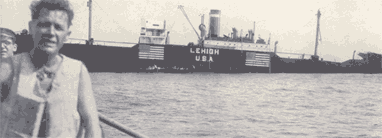
[Photo taken by 2nd Engineer James E. Earle. In the area beneath the flag and "Lehigh USA" are two lifeboats which took Sam Hakam, Joseph Manerchia and Richard Rice back aboard to rig an emergency radio aerial. Rice is on top of the rear mast in the photo. Published in LIFE Magazine Dec. 8, 1941]
We got off and pulled away fast. At a safe distance we stopped to watch the old SS Lehigh go down. It did not take long. The stem went down as the head raised up until the ship was straight up then down it went with a rumbling roar leaving some debris behind. The Captain waved his hat shouting, "Good by, old girl". We all felt a lump in our throats.
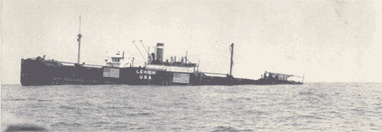
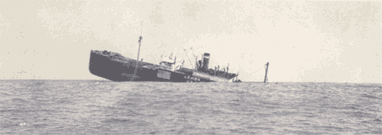
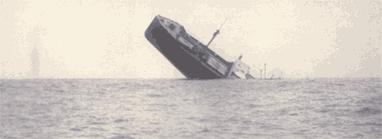
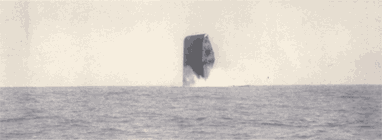
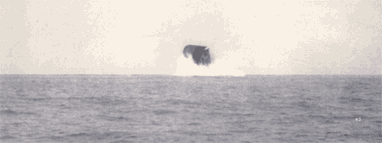
[Photos taken by Sam Hakam. Published in LIFE Magazine Dec. 8, 1941] Soon after, we all started throwing up. We were not used to the roll of a small boat and got seasick. Then from nowhere the sharks came. Round and round each boat the fins went. They never left us.
We tried to keep our four lifeboats together. But it proved impossible. They just drifted apart. Then we were horrified to find the stopper on our water barrel had worked loose and most of the water gone. We were near the Equator off the African coast where the sun gets very hot. The Captain rationed what water we had left to one cup per man per day.
We were about 70 miles off the coast so set out to row for it. We were soon exhausted. The Captain then decided we had better do our rowing at night. It was a good decision and we managed to get some miles closer to the coast. Then dawn came and the hot sun was with us again.
[At right, Sam Hakam in lifeboat, photographed by a shipmate. Published in ACA News, date unknown]
Our bodies got dehydrated, our tongues swollen, our mouth parched, we could barely swallow our precious water ration. All the time the sharks kept circling round and round.
The second night came. Black clouds formed above us. It looked like rain. Madly we spread out a sheet of canvas. We waited with bated breath. No rain came. Instead a storm hit us.
Our small boat was tossed about wildly. Good seamanship kept us afloat. It finally passed. I lay exhausted on the bottom of the boat and reflected there was only about one quarter inch of steel thickness between myself and hell.
The second day dawned. It was hot. We put cloths on the back of our neck, washed our faces with sea water, nothing seemed to help. We lay in a stupor. We were like a bunch of dead men.
Suddenly a shout. "A ship! Its coming our way!
Talk of the dead coming to life. We grabbed oars and rowed madly toward the oncoming boat. It wasn't needed. We had been sighted. But we were not taking any chances.
The boat circled us and its Commander [of a British destroyer] called out, "Are you Survivors"?
Of all the dumb questions. Our Captain assured him we were. Later, the Commander told us it was regulations to ask the question, but he was going to pick us up anyway.
We were brought in to Freetown, Sierra Leone and royally treated by the British there. We were given some clothes which had been donated by people in England and the US. I got a sweater with a tag saying it was from a Mildred with her name and address in New York. I looked her up. She was a very nice lady with a husband and four kids.
I picked up the Malaria bug in Africa. It hit me when I got home. I spent some time in the Marine Hospital in Staten Island. By the time I was ready to sail again Pearl Harbor had come and we were at war. I checked in for an assignment hoping for an easier time on this trip. It was not an easy trip. We were slated for Murmansk on Convoy PQ 16.
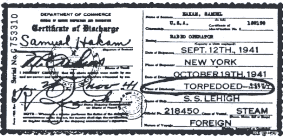
[Samuel Hakam's Discharge Certificate states "Place of Discharge: Torpedoed 8-26 N.L. 14-37 W.L." The SS Lehigh, a Hog Islander built in 1919 as the SS Senatobia, was en route from Bilbao, Spain to Takoradi, Gold Coast, in ballast. Four men were injured in the attack by the German U-126. The U-126 was sunk July 3, 1943 by the British Royal Air Force with no survivors.]
Brooklyn resident Samuel Hakam was born in 1907, died in 1995, at the age of 88. He went to sea as a radio operator in 1934. At the outbreak of WWII he went to France to join the American Ambulance Corps, but the French made him radio operator aboard a French ship carrying supplies between France and North Africa. When France surrendered, Hakam and his shipmates were stranded in Casablanca, Morocco, under observation for two months by Nazi agents, who learned of their plan to carry refugees to Canada.
He was drafted into the Army not long after he returned from Murmansk. He was posted to the Aleutians, where fellow GI Dashiell Hammett, author of Maltese Falcon, advised him on his writing. Then he was posted to Seattle, where he sat at a sub listening station at a former country club and figured, "Yeah, this is a tough job but somebody's got to do it." After 18 months in the Army, the Merchant Marine discovered his whereabouts and yanked him out and back onto a ship, as radio operators were scarce and badly needed.
All material above courtesy of Wendy Joseph, daughter of the late Sam Hakam.
Home
Past Features
Merchant Marine in WW26/5/00
www.USMM.org ©1999 Wendy Joseph. You may quote material on this web page as long as you cite Sam Hakam and American Merchant Marine at War, www.usmm.org, as the source. You may not use more than a few lines without permission. If you see substantial portions of this page on the Internet or in published material please notify usmm.org @ comcast.net